*This post was previously live on my other site TheWingedFork.com
Vast grasslands, majestic mountains and sandy deserts interspersed with modern cities and towns is what comes to mind when one thinks of Africa. Add to that safaris, camping, and exploring local African cuisine and you’d be in outdoor heaven. But even from the small towns of Lalibella and Windhoek to the busy cities like Nairobi and Cape Town, you’ll find something more that Africa has a lot to offer; her beautiful churches. The African continent is home to some of the most beautiful churches and cathedrals known to man. Here, gathered from different African countries are our favorites.
1. Moedergemeente in Stellenbosch, South Africa
By Sarah, writer at The Winged Fork
Moedergemeente or NG Kerk is second oldest church in South Africa built back in 1686. It is located at the end of the church street lined with art galleries and tall trees. The surroundings are really peaceful and when you enter the church you get a glimpse of its simple, yet beautiful artwork. What surprised us was that the Church does not have an altar like most other churches. It has beautiful wooden pulpit where the altar would normally be.
The pipe organ in the church is especially lovely while the colorful stained glass windows add a surreal serenity to the church.
2. Livingstonia Church, Malawi
By Rachel from Rachels Ruminations
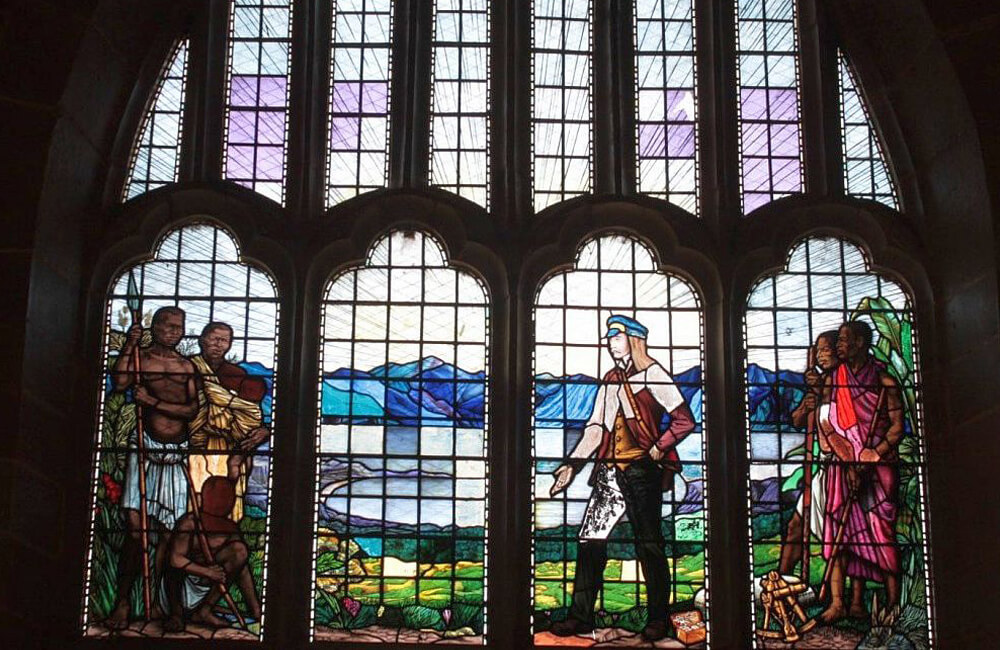
Livingstonia Church is not as ornate or ostentatious or historic as many of the churches you’ll read about here. Nevertheless, it’s one of my favorites. Livingstonia, a small town in northern Malawi, sits high above Lake Malawi on a steep escarpment. The Free Church of Scotland missionaries who founded the town in 1894 chose this hard-to-reach site in their effort to escape the malaria that had killed many of their predecessors down on the more accessible lakeshore. The red-brick buildings in this tree-shaded town are, in my view, charming for their turn-of-the-century simplicity.
The church is just as simple and unadorned, except for a large stained-glass window over the entrance door. The window expresses the Scottish missionaries’ patronizing views by depicting David Livingstone (as in Stanley’s famous question “Dr. Livingstone, I presume?”) preaching to scantily-clad natives under rays of light from heaven.
Getting to Livingstonia is not easy, involving a drive up the escarpment on an unpaved, poorly-maintained road, including more than 21 hairpin turns. It’s worth it, though, for the charm of the colonial-era buildings and for the gorgeous views over the lake. To read more about it, go to Livingstonia: A Glimpse of Malawi’s Colonial Past.
3. The churches of Lalibela, Ethiopia
By Clemens from Travellers Archive
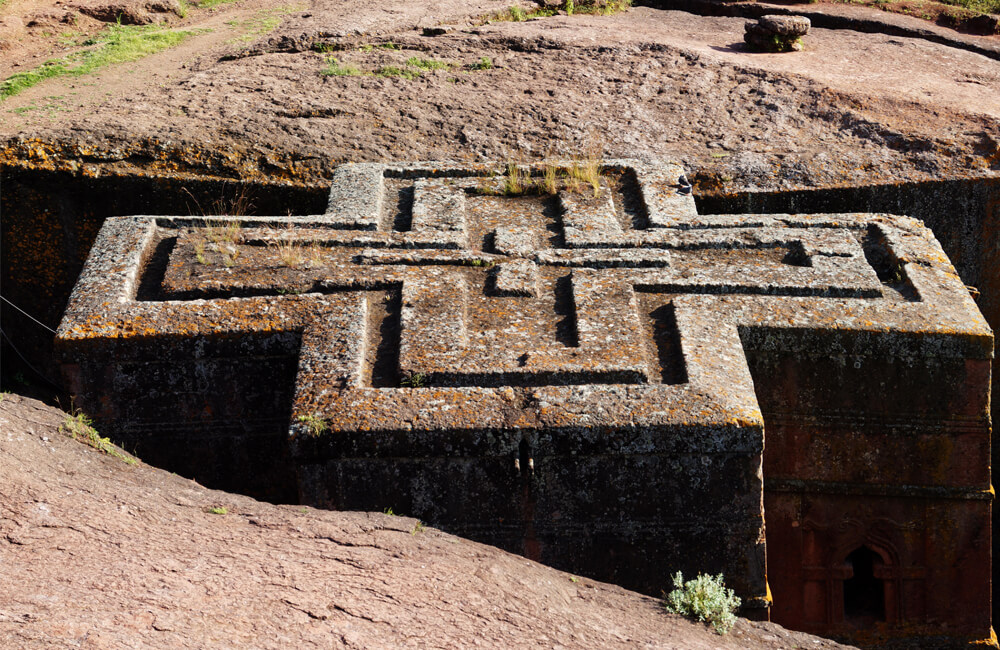
They say, they were built by angels, but nobody knows: The churches of Lalibela are a true wonder and one, that must have been an absolute challenge to build. Located in the North of the Eastafrican country Ethiopia, you’ll find the 11 stunning rock-carved churches of Lalibela. All of them have been built, roughly, in the 12th and 13thcenturies and are assembled in four different groups that can be explored within two days. As each individual church tells its own story, it’s recommendable to take a local guide who knows all the background information. Also, when visiting the churches, you are obliged to take off your shoes. Hence, walking around the churches for an entire day results in a lot of taking off and taking on of shoes. In order to facilitate this thing, there are official shoe people that you can hire at the entrance of the whole area, where you also buy your tickets. These guys will follow you around, watch and arrange your shoes each time you take them off and will be happy to assist you.
Do some research and come here when there is an official holiday as then a lot of Orthodox Ethiopians would go on a weeks long pilgrimage to the churches in order to sing and pray together. This is a stunning thing to see and should not be missed.
4. Saint Catherine’s Monastery in South Sinai, Egypt
By Moheb, The Wanderer Pharaoh

Saint Catherine’s Monastery is located in South Sinai in Egypt. It was built by The Roman Emperor Justinian at the site of the burning bush where God talked to Moses. The Monastery lies at the bottom of Mount Sinai where it is believed to be the mountain where God talked to Moses and gave him the Ten Commandments.
Although the monastery was built between 548 and 565 AD, there was a monastic settlement at the beginning of the fourth century. The monastic life was recorded in a manuscript written between 381 and 384 AD. The Manuscript was written in old Latin by a woman named Etheria in her book: The Pilgrimage of Etheria. And through the ages, the monastery was neither destroyed nor abandoned.
The Monastery is named after Saint Catherine, an early Christian martyr. Saint Catherine was a princess and was beheaded in the fourth century by the hands of Emperor Maxentius after converting hundreds of people to Christianity. And according to the Coptic traditions, angels took her remains to the peak of Saint Catherine Mountain, the highest peak of Sinai Mountains where it was found later by the monks.
Christians, Jews and Muslims consider Mount Sinai and Saint Catherine region a holy place. So, pilgrimages have been hiking Mount Sinai since the early decades of Christianity. Today, Saint Catherine and Mount Sinai hike is the most famous in Egypt. Some do it for spiritual reasons, while others do it as a sport and for the breath-taking landscapes of the mountains.
The typical hike starts at the night to watch the sunrise from the peak of Mount Sinai. Then Hikers visit the Monastery on their way down in the morning. The major sightseeing at the Monastery is the burning bush, Saint Helen chapel and the monastery library which preserves the second largest collection of manuscripts in the world.
5. The Hanging Church in Cairo, Egypt
By Moheb, The Wanderer Pharaoh
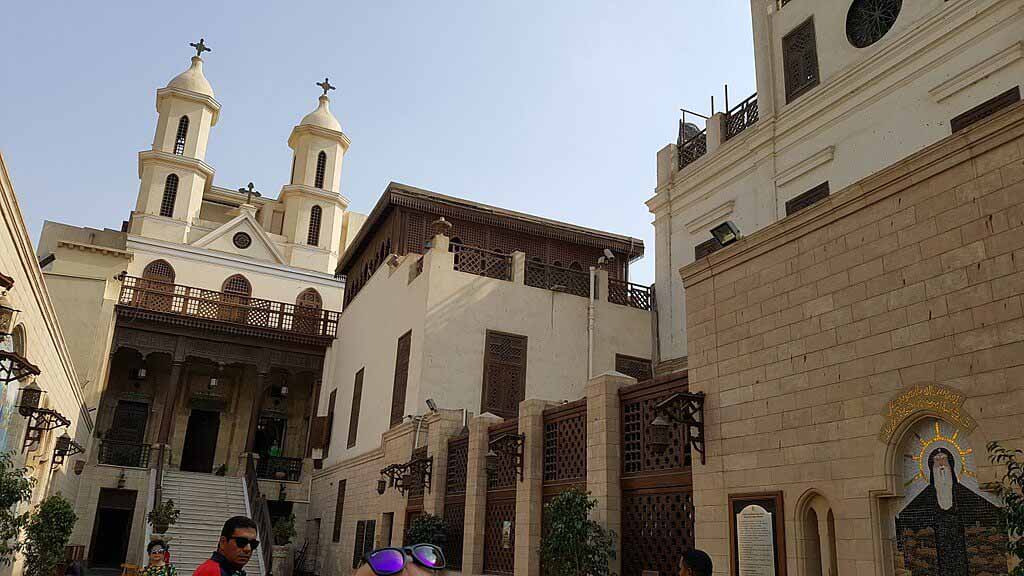
Pic by ovedc from Wiki commons CC by SA 4.0
The Hanging Church lies in Cairo – the Egyptian Capital – in The Coptic Cairo area. The Church was originally named The Church of Mother of God Saint Mary. But it is commonly known as The Hanging Church because it was built over two towers of Babylon Fortress. Babylon fortress is an ancient Roman Fortress built in the second century. The Hanging Church is the most famous and visited church in Cairo and one of the oldest churches in Egypt.
The Church is very close to the Church of St. Sergius and Bacchus (see number 13 below) where the Holy Family took shelter, during their 3 years they spent in Egypt fleeing Herod. The original church on the same site was built in the third century. But, the current church was built around 690.
The Hanging Church was built in Basilica architecture. Its wooden roof has the shape of Noah’s ark. Also, the wooden screen is decorated with geometric patterns and crosses made from ebony and ivory.
Travelers usually visit The Hanging Church as a part of Coptic Cairo tour. The tour usually includes the Coptic museum, Babylon Fortress and several old churches around the fortress. Some travelers who have limited time in Cairo visit Islamic Cairo on the same day. As, both Coptic and Islamic Cairo lie close to each other in what is currently known as Old Cairo.
Related Post
Top Latin American Churches that you must visit!
6. Christuskirche in windhoek, Namibia
Oksana & Max from Drink Tea & Travel

Pic by Max and Oksana from Drink Tea and Travel
Christ Church (or Christuskirche) is perhaps the most well-known attraction in Windhoek, Namibia. Built during the early 1900s, the church’s interesting architecture stands out in the city center. It was designed by Gottlieb Redecker with unique Neo-Romanesque, Art Nouveau, and Gothic style architecture.
It was built with many imported materials like stained glass donated by the German Emperor Kaiser Wilhelm and marble imported from Italy. However, a mine was open nearby to obtain for the sandstone which clads the exterior.
Christ Church still operates as a Lutheran church today but only operates Sunday services in German! The church is a strong reminder of Namibia’s German colonial heritage. You can step inside for a visit during the opening hours but the church is more impressive to admire from the outside. There is a plaque outfront which delves into the history of the church and when the first stone foundation was laid.
Next door is the pretty Parliament Gardens and the bronze statues of Namibian nationalists. They are worth a visit in their own right but also offer interesting views of the church.
7. Church of Our Lady of the Rosary in Asmara, Eritrea
By Stephen of Asia Hikes
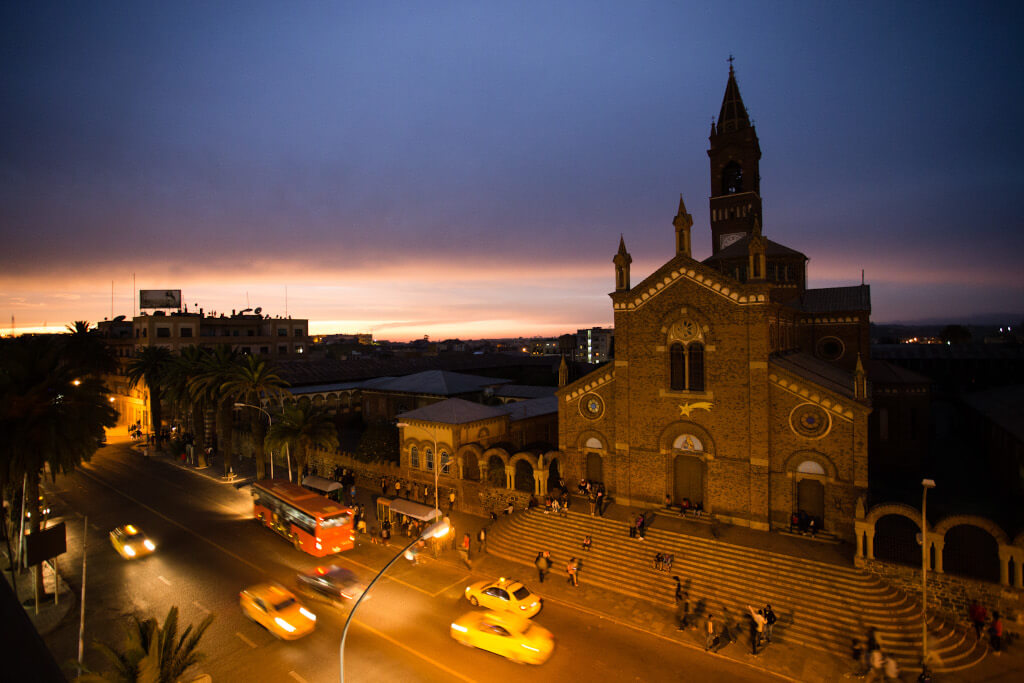
The Church of Our Lady of the Rosary is in the Lombard Romanesque style, constructed in the 1920’s at the height of the colonial period when Asmara was the capital of Italian Eritrea. The seat of the Roman Catholic Church in the region, the congregation flourished during the Italian occupation but saw sharp declines after Italy lost possession of Eritrea at the end of World War II. An inscription inside the church notes WWII-era dictator Benito Mussolini as one of the primary benefactors of the building’s construction, while damage inflicted during the war was largely repaired with the contributions of the now-dwindling local Italian community.
Occupying a central position on Asmara’s main thoroughfare, Harnet Avenue, the building remains a landmark in Asmaran life and is colloquially referred to as ‘The Cathedral’ (though this is not technically accurate) despite the presence several kilometers away of an Eritrean Orthodox Cathedral of much greater religious significance to the majority of the local population.
Though of far reduced religious significance in the modern era, the building is one of many 1920-30s constructions that define the architecture of Asmara, complimenting many Italian-built Art Deco buildings to establish the city’s UNESCO-listed status as a World Heritage Site.
8. Nossa Senhora de Baluarte, Mozambique Island
By Wendy of The Nomadic Vegan
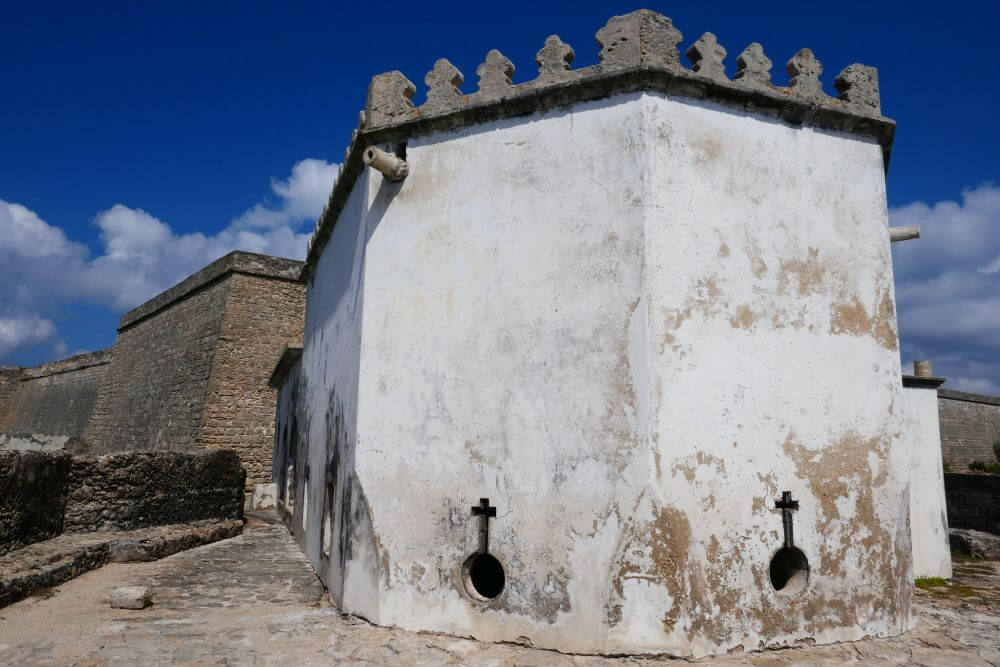
This chapel is located on the very northern tip of Mozambique Island, which was once the capital of colonial Portuguese East Africa. Built in 1522, it’s the oldest European building in the southern hemisphere that’s still standing. Its strategic location explains why it was built with both religious and defensive purposes in mind. And indeed, in many ways, it looks more like a fort than a church. One of the few clues that it is in fact a place of worship is the cross-shaped openings in the otherwise windowless walls.
Even the chapel’s name evokes images of war and defense. The Portuguese word “baluarte” means bulwark or bastion, so this is the Chapel of Our Lady of the Bastion. More than a century after the Portuguese colonists built the chapel, they built the São Sebastião Fort right next to it, taking over the chapel’s defensive duties. From this point on, the chapel was used purely for religious services. Inside is a lovely vaulted ceiling over the apse, while the ceiling of the nave consists of exposed wooden beams. The chapel is undoubtedly one of the highlights of a visit to Mozambique Island, particularly for history buffs. The island is not so easy to get to, but once you arrive you may never want to leave. You’ll be enchanted by its crumbling architecture, beautiful sunsets and delicious Mozambican food.
9. Sainte Anne of the Congo, Brazzaville
By Wendy of The Nomadic Vegan
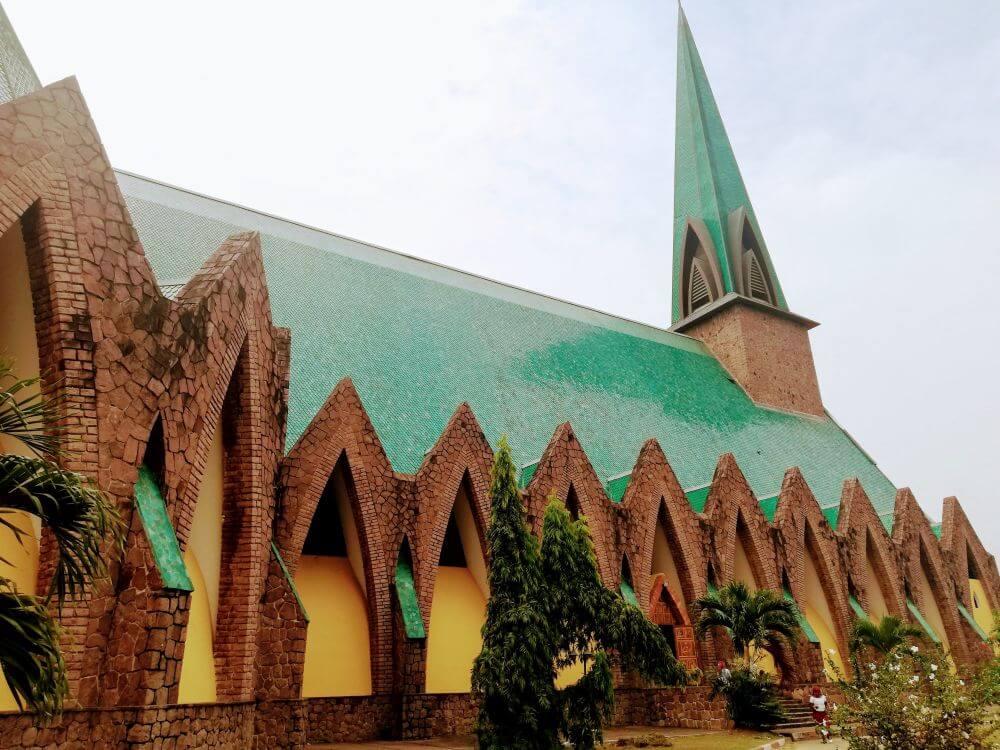
While the Basilique Sainte Anne du Congo is a Catholic church, it was actually built by a Protestant architect from France in 1943. It’s easily the most beautiful building in Brazzaville, now the laidback capital of the Republic of the Congo. At the time when it was built, though, in the early 1940s, Brazzaville was the capital of France Libre, or “Free France”. Even though it was still a French colony, it was not controlled by the Vichy regime, which was collaborating with Nazi Germany. Instead, this was the headquarters of Charles de Gaulle’s government in exile, which continued to resist the Nazis.
And the basilica was built to represent the power of this exiled French government, sending the message that Free France would stand strong against tyranny. In the end, though, it wasn’t consecrated as a place of worship until several years after World War II had ended, and even then the bell tower remained unfinished until 2011. But now it’s finally complete, and the daily morning mass is generally well attended. It’s also a popular venue for weddings, and you may see one in progress if you come on a weekend. Visiting the basilica is definitely one of the best things to do in Brazzaville and should not be missed.
10. Igreja Nossa Senhora da Luz on Maio island, Cape Verde
By Paulina of Paulina on the Road

The Church Nossa Senhora da Luz is located in the capital of the small island Maio, Cape Verde. For me, it’s one of the prettiest churches in Cape Verde thanks to its strategic location. Climb up the stairs and you’ll have a 180 degrees panorama view and on special days you can even spot Santiago island.
Most often you’ll find the church framed by pink bougainvilleas which makes it one of the best photo motives on the island. The architecture is inspired by the Portuguese colonisators and the contrast between yellow and white is one of the prettiest aspects.
If you are looking for further things to do on the paradise island Maio, its virgin beaches and turtles nesting tours are part of every Cape Verde travel guide. It’s one of the least visited islands but also one of the prettiest Cape Verdean islands.
11. Cathedral of St Michael and St George, Grahamstown, South Africa
By Ed from SafarisAfricana
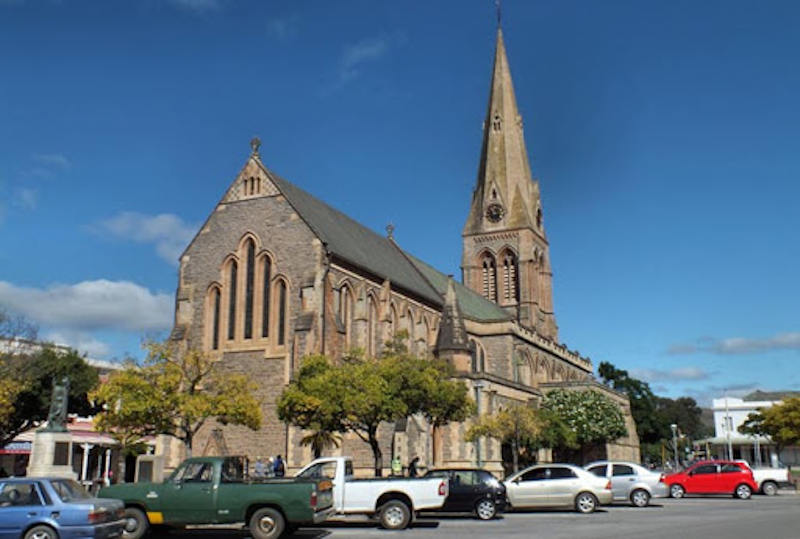
The Cathedral of St Michael and St George is a beautiful church in Grahamstown, in South Africa’s Eastern Cape. Though Grahamstown may be a little out of the way for most South African itineraries, the town is underestimated as a place to soak up some of South Africa’s history. The cathedral enjoys the claims to fame of having Africa’s highest spire at 54 meters and having the first ring of bells to be installed in Africa, in 1879.
The cathedral was conceived in 1824 and consecrated in 1850 when Graham’s Town was a military outpost on the Eastern Frontier of Britain’s Cape Colony. At that time there were no cathedrals in South Africa – which was served by the Bishop of Calcutta, India – but the growing British population of around 3,000 persuaded the colonial treasury to provide the £4,404 needed to fund the construction.
Today the church retains much of its historic charm, with stunning stained glass windows, wooden pews, bibles, and hymn books available to take a moment of reflection. If you’re lucky you’ll be in town for one of the many performances by choral choirs from across the country, which are well worth attending.
The cathedral is open to visitors from 9am to 3pm, Monday to Friday and 9 am to 12 noon on Saturdays, and is easily found without GPS or a map, as it can be spotted from almost anywhere in Grahamstown!
12. Abuna Yemata Guh in Tigray, Ethiopia
By Margherita of The Crowded Planet

The Tigray region in northern Ethiopia is known for its beautiful cave churches, most of which are hidden in the sandstone mountains – and getting to them is half the fun. This is especially true for Abuna Yemata Guh, probably the most famous of all 120 Tigray churches – both for its beautiful cave paintings and for the hair-rising hike to get there.
The base to visit Abuna Yemata Guh is the dusty town of Hawzen, where you can arrange for a guide. It’s compulsory to have one to visit the church, and you’ll soon understand why!
Your visit to Abuna Yemata Guh starts at the foot of the Gheralta mountains. The hike is easy at first, climbing gradually, then gets steeper and steeper, with steps and some stages where you’ll need to scramble. Then, you’ll find yourself in front of the main challenge – a 15 meter high rock wall you’ll need to climb. You can do so with the aid of ropes, or by using foot and handholds carved in the rock face by pilgrims over time.
After the wall, there’s another short climb, and a walk along a narrow ledge with a 200 meter drop on the side. Not for the faint of heart, let me tell you!
Once you get to the actual church, you’ll be rewarded with a magical, spiritual atmosphere, and by wonderful 1000-year old wall paintings. Your guide will be able to explain all the paintings, and if you are a believer, you’ll definitely be invited to join locals for a prayer.
13. Church of St. Sergius and Bacchus in Cairo, Egypt
By Nick of Wandering Wheatleys

Finding the Church of St. Sergius and Bacchus is no easy feat. Located in the older portion of Coptic Cairo, you’ll need to descend the stairs to the Coptic Cairo Bazaar and then wind your way through the small subterranean alleyways.
This church doesn’t look like much from the outside, but it holds a significant place in history. Not only is the Church of St. Sergius and Bacchus one of the oldest Coptic churches in Cairo, but it’s also believed to be built over the place that Joseph, Mary, and baby Jesus took shelter after they arrived in Egypt. So if you’re interested in religious history then you’ll definitely want to add this stop to your Cairo itinerary.
The interior of the church is impressive with ancient brick walls and huge wooden roof trusses holding the cambered ceiling aloft. This church was originally constructed in the 4th century but has undergone multiple reconstructions and renovations throughout the years.
Most visitors, however, come to visit the small crypt below where the Holy Family lived temporarily. It’s a rather small space beneath the church so you’ll need to queue up. As the line of visitors files through, everyone stops momentarily to say a quick prayer or snap a photo.
On your way out make sure you check the intricate woodwork of the chancel and the collection of religious icons along the south wall.
14. Church of St. Andrew in Tangier Morocco
By Eva of NotScaredoftheJetLag

The St. Andrew’s church is very conveniently located in central Tangier. Just up the street from the main square, Grand Socco, it should be part of any sightseeing in Tangier.
In 1880, the current leader Hassan I, donated some land to the Christian community in Tangier to build a church. It is still in use today with a service every Sunday morning. The ground keeper speaks good English and will most likely be available for a tour.
The church is an interesting mix of Anglican and Moroccan architecture and design. At first glance, the outside looks just like any English small-town church, just painted white. But at a closer look, you will notice that the tower actually resembles a minaret, with typical Islamic stucco decorations.
Inside there are typical wooden pews on both sides of the aisle, leading up to the altar. The altar room is facing Mecca, just like the Mihrab in a mosque would be. It even has a small niche in the eastern wall with inscriptions from the Quran. The entrance to the altar room resembles a Moroccan Bab, a city gate. It is surrounded by stucco calligraphy, featuring the Lord’s prayer in Arabic words.
The church is set in a small yard, with graves of former members of the congregation, some apparently famous in the area. Some parts of the graveyard are rather overgrown, and it is nice to look around for the oldest tombstone.
It is free to visit St. Andrew’s church, but consider a small donation towards the upkeep of the church and graveyard.
15. Mai Mahiu Italian Church in Kenya
By Nadine of The Expat Mummy
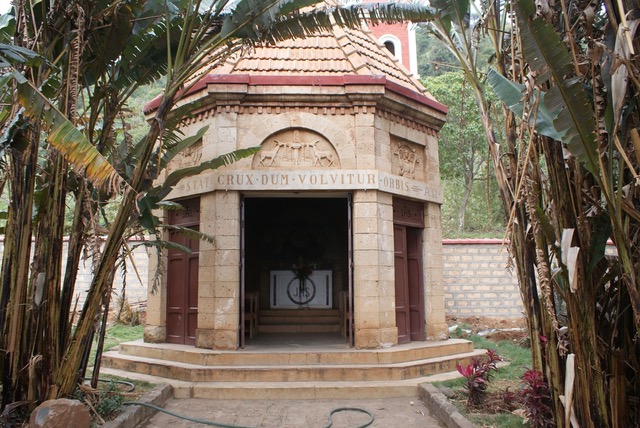
At the bottom of the Rift Valley in Kenya lies of the world’s smallest churches, the Mai Mahiu Church. Driving from Nairobi you descend over 1000 metres from the top of the Nairobi highlands to the bottom of the deepest rift on earth, a tear that stretches 8 countries and xx miles. As you reach the rift floor, an unusual sight greets you, a church so out of place in Kenya that no one can miss it. A tiny Italian style church nestled in the rockface of valley wall. A church built from sandstone and red tiles, one of the smallest churches in the world, seating just 12 people, and a church built by Italian prisoners of war.
Mai Mahiu, church was built by forced labour in 1942 during the Second World War when British forced captured more than half a million Italian soldiers. The building of the church was fraught with danger, many of the POW’s were killed by wild animals, lion, leopard, elephant and buffalo roamed the land during the 1940’s, to this day leopard, lion and buffalo can still be found in the area.
The pentagon-shaped Mai Mahiu church is covered in Latin inscriptions and symbols. They adorn the walls, stained glass windows and the entrance doors. Inscriptions such as Quae Vincit Mundum Fides Mustra (This is the victory that has won the world by our faith) and Benedicite Coeli Domino Benedicite (Blessed be the sky and blessed again) are particularly poignant given the circumstances in which the church was built.
Today the church is well-loved but little used, a sign of bygone days on the journey from the highlands to the Rift floor.
If you’re looking for churches from Europe, the list is here. The churches in Asia are here and the churches in Latin America and Australia are here, and finally the Northern American churches to visit are here. Happy reading!
Other Lists of Places to Plan Your Travels
- Churches in Asia
- Most Beautiful Churches in Europe
- Kumbalgarh Fort in Rajasthan
- Colosseum must-know facts
- Buy these Christian books

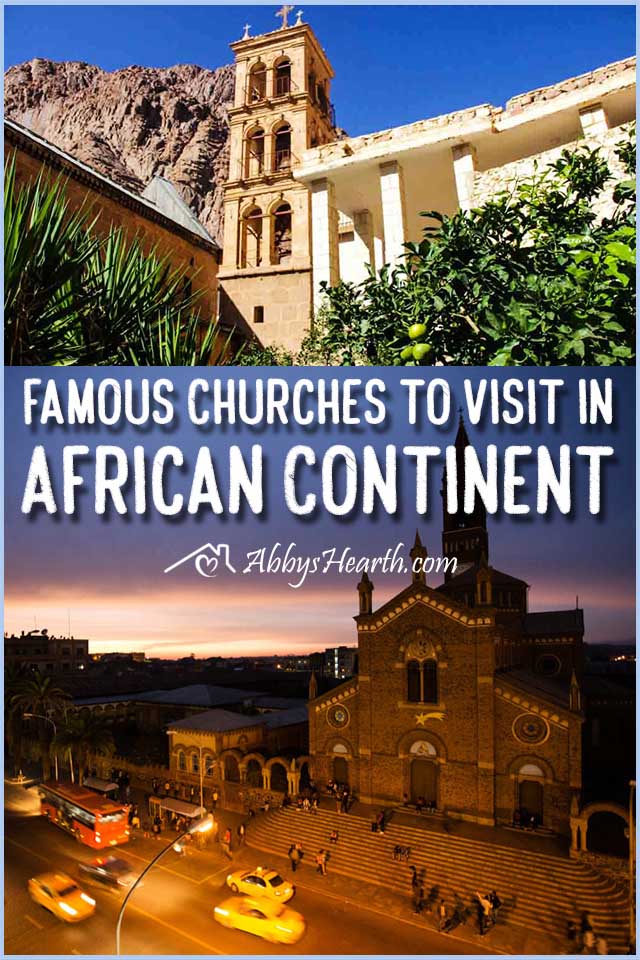

And a PS! If you’re a lifestyle or travel blogger with a church you want to add to this list, please ping me at abby@abbyshearth.com

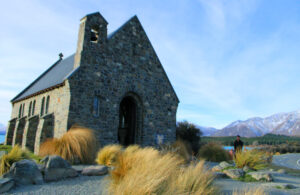
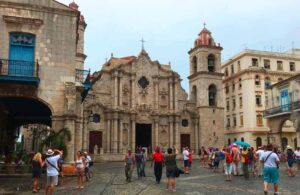

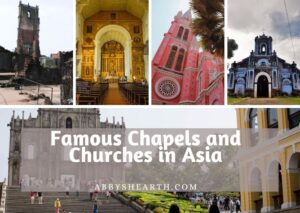

Great Post as always. Some of my favorite African churches are on here.
Thank you for sharing such a great list of African churches.
Great post.Thank you for sharing such an inspiring information.